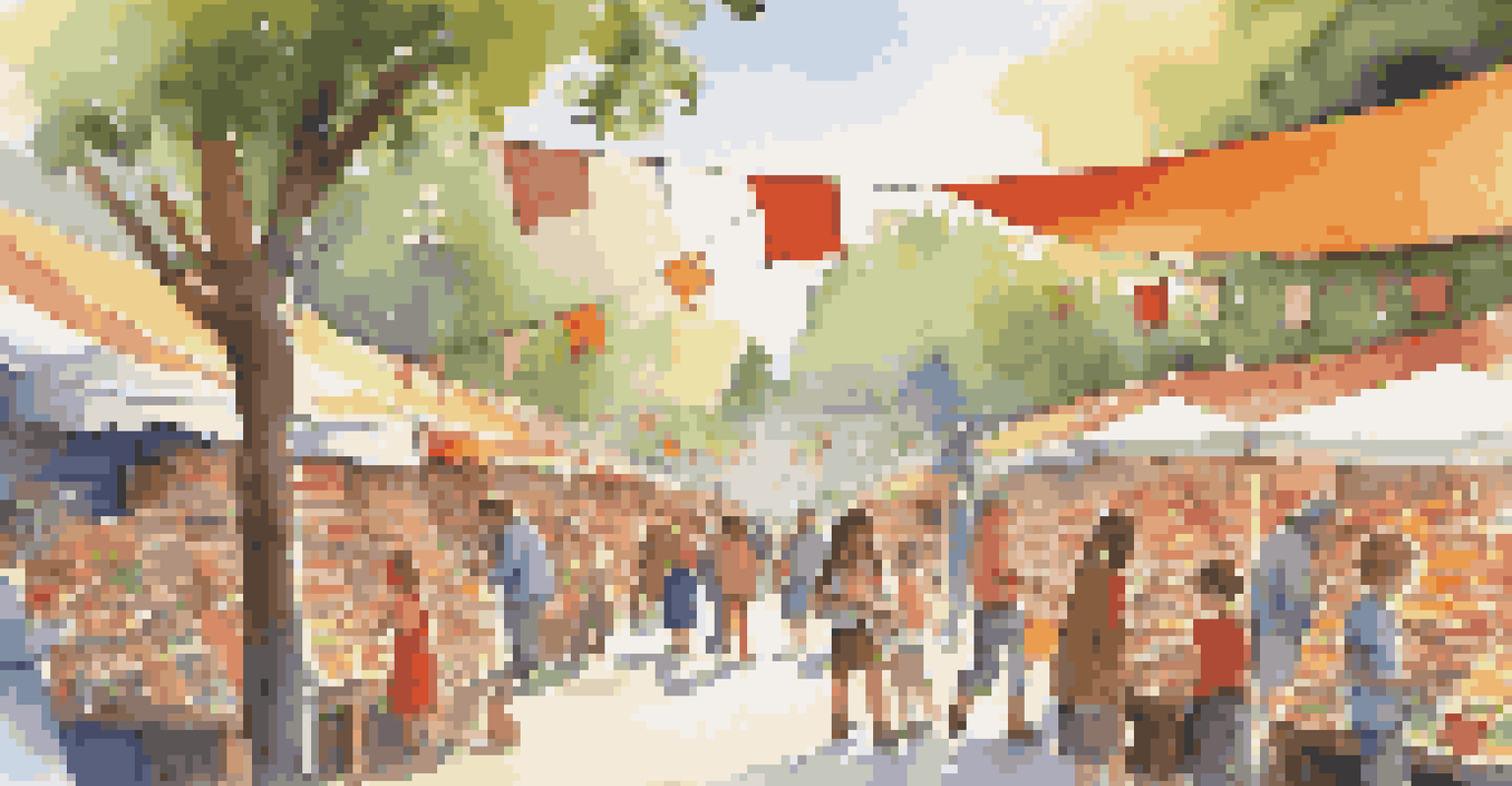The Influence of Social Media on Reading Trends Today

Social Media's Role in Shaping Reader Preferences
In today's digital age, social media platforms have become a significant influence on what people choose to read. Users often discover new books through recommendations, trends, and viral content shared by friends or influencers. This creates a community where reading preferences are continuously evolving, reflecting the latest popular titles or genres.
Books are a uniquely portable magic.
For instance, when a popular book is featured on TikTok, it can lead to a surge in sales, a phenomenon known as 'BookTok'. Readers often find themselves diving into genres they might not have considered before, as a result of these social interactions. This communal aspect of social media not only helps readers find new interests but also fosters discussions around books.
As readers engage with content on platforms like Instagram and Twitter, they’re more likely to share their thoughts and reviews. This ongoing dialogue helps form a collective consciousness around reading, significantly impacting which books gain traction and ultimately shape reading trends.
The Rise of Shorter Content and Its Effects
With social media's focus on quick, digestible content, many readers are turning toward shorter forms of writing. This shift can be seen in the popularity of novellas, essays, and even social media threads that encapsulate entire narratives. Readers often appreciate the ability to consume content quickly, which aligns with their fast-paced lives influenced by constant notifications and updates.

Moreover, this trend has led to a decline in long-form reading, as people may choose to scroll through summaries or quotes instead of diving into full-length books. While this can encourage initial interest in a topic, it may also limit deep engagement with the material. The challenge for authors and publishers is to find a balance between captivating short content and longer, more enriching reads.
Social Media Influences Reading Choices
Platforms like TikTok and Instagram shape reader preferences by promoting popular books and engaging communities.
As a response, many authors are experimenting with formats that combine traditional storytelling with modern brevity, appealing to an audience that craves both depth and accessibility. This evolution in reading habits showcases the adaptability of literature in the face of changing consumer preferences.
Influencer Culture and Book Recommendations
Influencers have emerged as powerful voices in the literary world, often steering their followers toward specific books with their recommendations. Platforms like YouTube and Instagram have become hotspots for book reviews, unboxings, and reading challenges, making it easier for readers to discover new titles. The personal touch of an influencer's endorsement can make a book more relatable and appealing to potential readers.
In the digital age, the book is no longer just a book; it’s a conversation starter.
Take, for example, the rise of 'Bookstagram' accounts where users curate visually stunning posts featuring their latest reads. These aesthetically pleasing showcases can entice followers to explore certain books simply because they look appealing in a photo. This visual element has transformed how readers connect with literature, adding a layer of creativity to the book discovery process.
However, this trend also raises questions about authenticity, as some influencers may be driven by sponsorship deals rather than genuine enthusiasm for the books they promote. As readers become more discerning, they often seek influencers who provide honest and thoughtful content, emphasizing the importance of credibility in today's reading landscape.
Hashtags and Their Impact on Book Discoverability
Hashtags have revolutionized the way readers find new content on social media. By simply searching for a hashtag like #BookRecommendations or #WhatToReadNext, users can access a treasure trove of suggestions from a global community. This accessibility not only democratizes book discovery but also allows niche genres to gain visibility that they may not have received through traditional marketing channels.
For instance, readers looking for specific themes or diverse authors can easily find curated lists that resonate with their interests. This targeted approach to discovering literature encourages readers to expand their horizons and explore books that they might not come across in mainstream bookstores. Hashtags foster a sense of community and connection among readers with similar tastes.
Shorter Content Gains Popularity
The demand for quick, digestible reading is leading to a rise in novellas and essays, impacting traditional long-form literature.
Moreover, authors and publishers can leverage hashtags to promote their work, creating campaigns that engage users effectively. This two-way interaction often leads to increased book sales and a dedicated readership, highlighting how social media can serve as a powerful tool for both discovery and marketing.
The Impact of Online Reading Communities
Online reading communities, such as Goodreads or various Facebook groups, have become essential platforms for book lovers to connect and share their thoughts. These spaces allow readers to post reviews, join discussions, and even participate in reading challenges, creating a vibrant ecosystem around literature. The sense of belonging to a larger community can enhance the reading experience by providing a platform for shared enthusiasm.
In these communities, readers often find accountability through group reads or buddy reads, motivating each other to finish books and expand their reading lists. This collaborative spirit not only fosters a love for reading but also encourages individuals to step outside their comfort zones and explore unfamiliar genres. The collective energy of these groups often leads to a surge in discussions about diverse and underrepresented voices.
Furthermore, these communities can serve as a valuable source of feedback for authors. By engaging directly with their readers, authors can gain insights into what resonates and what doesn’t, shaping their future works. This dynamic interaction between readers and writers illustrates the evolving landscape of literature in the digital age.
Reading Challenges and Trends on Social Media
Social media has given rise to various reading challenges that encourage users to read more and explore different genres. Popular challenges, like the Goodreads Reading Challenge, motivate participants to set goals and track their progress, often leading to increased engagement with books. These challenges can create a sense of camaraderie as users share their accomplishments and inspire each other along the way.
Additionally, themed reading challenges, such as 'Read a Book by a Female Author' or 'Classics Revisited', help diversify reading habits. This not only broadens readers' perspectives but also promotes discussions about representation and inclusion in literature. The community aspect of these challenges fosters a supportive environment where readers feel encouraged to explore new titles.
Online Communities Enhance Reading
Reading communities foster connection and accountability, encouraging readers to explore diverse genres and share experiences.
As readers participate in these challenges, they often share their experiences online, using specific hashtags to document their journey. This visibility not only motivates more people to join but also promotes a culture of reading that is both fun and engaging. Such trends highlight how social media can effectively harness collective enthusiasm for literature.
The Future of Reading in a Social Media World
Looking ahead, the relationship between social media and reading is likely to continue evolving. As technology advances and new platforms emerge, the way we consume and engage with literature will inevitably change. Potential innovations, such as virtual reality book clubs or interactive storytelling, could redefine the reading experience and attract a younger audience.
Moreover, as social media becomes more integrated into our daily lives, the challenge will be finding a balance between screen time and reading time. While social media can encourage reading, it can also distract from it. Readers will need to be mindful of how they allocate their time, ensuring that they still engage deeply with literature.

Ultimately, the fusion of social media and reading presents both opportunities and challenges. By embracing this interconnectedness, readers and authors alike can navigate the digital landscape while fostering a rich and diverse literary culture that reflects the interests and values of today’s society.